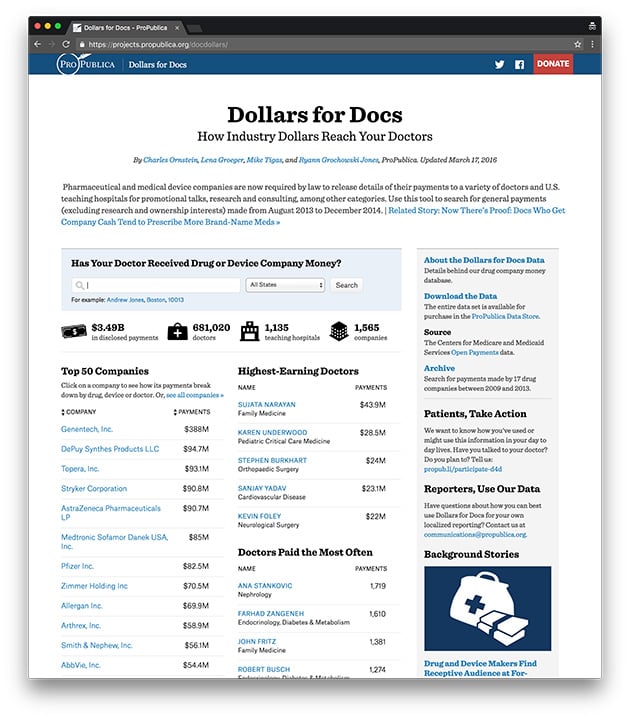Today we’ve updated our Dollars for Docs interactive database, adding an additional year of data and some new features that make it easier to see how much money your physician receives from pharmaceutical and medical device companies.
Dollars for Docs now includes payments made from August 2013 through December 2015.
Two full years of the data gives us the chance to compare year over year. Although spending by companies stayed constant, the numbers are nevertheless huge. Companies made about $2 billion in general payments to 618,000 physicians each year, in addition to another $600 million a year to teaching hospitals. General payments cover promotional speaking, consulting, meals, travel, gifts and royalties, but not research. The specific doctors who received payments changed quite a bit from 2014 to 2015; a quarter of doctors who received a payment in 2015 didn’t receive one in 2014, and vice versa.
The 10 drugs for which companies spent the most in payments to physicians in 2015 (teaching hospital payments not included) were blood thinner Xarelto ($28.4 million), rheumatoid arthritis drug Humira ($24.9 million), diabetes drug Invokana ($20.9 million), hepatitis C drug Viekira ($19.2 million), blood thinner Eliquis ($18.8 million), diabetes drug Bydureon ($18.5 million), testosterone drug Androgel ($15.3 million), thyroid drug Synthroid ($14.7 million), synthetic hormone Lupron ($14.3 million) and diabetes drug Victoza ($11.9 million).
Viekira is one of a handful of drugs seen as breakthroughs because they cure hepatitis C with fewer side effects than older treatments. Its better known competitors Sovaldi and Harvoni were also backed by millions of dollars in payments to doctors, but were slightly lower on the list.
As ProPublica has previously reported, however, many of the drugs most aggressively promoted to doctors aren’t cures. Some are top sellers, but most are not. Less expensive generic alternatives are available for some of the drugs on the list.
With the addition of the 2015 data, our Dollars for Docs dataset now contains nearly $6.25 billion in medical industry payments made to more than 800,000 physicians in the U.S. Researchers can purchase the data through our Data Store.
Combining previous payment data with prescribing data from the federal Medicare program, we’ve shown that physicians who receive payments from the industry tend to prescribe more brand-name drugs than those who don’t. Several academic studies later had similar findings. We also recently reported that companies continue to work with thousands of doctors who have received disciplinary sanctions against their licenses.
The disclosures included in Dollars for Docs were required under the Physician Payments Sunshine Act, a part of the 2010 Affordable Care Act. Prior to the law’s implementation, ProPublica tracked payment disclosures for 17 companies, most of which were required to release them publicly under the terms of lawsuit settlements. You can find the archived Dollars for Docs data at https://projects.propublica.org/d4d-archive/.
A bill before Congress this year would have watered down some of the disclosure requirements in the Sunshine Act, but the proposal was stripped from the 21st Century Cures Act before it passed.






